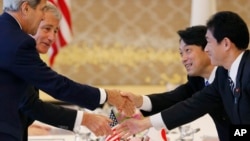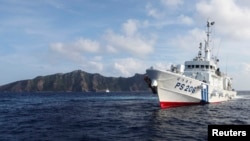SEOUL —
The United States and Japan have agreed to boost regional military surveillance amid territorial tensions with China and nuclear and missile threats from North Korea. After security talks in Tokyo, U.S. defense officials also welcomed Japan playing a larger role in its own national defense.
For the first time, the Pentagon will rotate long-distance surveillance drones to Japan and deploy its new P-8 maritime patrol aircraft.
The two sides' top defense chiefs and diplomats also agreed to position a second missile defense radar in Japan.
U.S. Secretary of Defense Chuck Hagel outlined the purpose of the early warning system. “This additional radar will bolster our ability to defend the U.S. homeland and Japan against North Korean ballistic missiles. And, it enhances an important 21st century alliance capability,” Hagel explained.
Although the missile radar is aimed at North Korea, the advanced surveillance equipment is likely geared towards China.
Beijing sends frequent patrols near the Japan-administered Senkaku islands that China also claims and calls the Diaoyu.
A joint statement issued by the U.S. and Japan Security Consultative Committee urges China to adhere to international norms.
Hagel reaffirmed the Senkakus fall under U.S. treaty obligations to Japan.
“We strongly oppose any unilateral coercive action that seeks to undermine Japan's administrative control,” he stated.
The joint statement also outlined U.S. and Japan joint projects for defense against cyberattacks, intelligence sharing, and cooperation in space.
The two sides also agreed to revise the U.S.-Japan defense alliance to give Tokyo a greater role in protecting its own sovereignty.
Prime Minister Shinzo Abe has been seeking to revise parts of Japan's pacifist constitution, raising concerns from its neighbors.
But, the United States welcomed Tokyo's greater defense role, saying the goal was a more balanced and effective alliance with the two militaries as full partners.
U.S. Secretary of State John Kerry said their discussions would modernize both military and diplomatic cooperation.
“Today we agreed to review our bilateral defense guidelines, and in the months ahead we will work together in order to shape the framework that will guide our alliance for the years to come,” he said.
They agreed a committee would submit recommended changes to the 1997 Guidelines for U.S.-Japan Defense Cooperation by the end of 2014.
The United States and Japan also reaffirmed a plan to move 9,000 U.S. troops out of military bases in Okinawa.
More than half of the soldiers would go to the U.S. Pacific island territory of Guam in the next decade with Japan agreeing to pay up to $3 billion of the cost.
For the first time, the Pentagon will rotate long-distance surveillance drones to Japan and deploy its new P-8 maritime patrol aircraft.
The two sides' top defense chiefs and diplomats also agreed to position a second missile defense radar in Japan.
U.S. Secretary of Defense Chuck Hagel outlined the purpose of the early warning system. “This additional radar will bolster our ability to defend the U.S. homeland and Japan against North Korean ballistic missiles. And, it enhances an important 21st century alliance capability,” Hagel explained.
Although the missile radar is aimed at North Korea, the advanced surveillance equipment is likely geared towards China.
Beijing sends frequent patrols near the Japan-administered Senkaku islands that China also claims and calls the Diaoyu.
A joint statement issued by the U.S. and Japan Security Consultative Committee urges China to adhere to international norms.
Hagel reaffirmed the Senkakus fall under U.S. treaty obligations to Japan.
“We strongly oppose any unilateral coercive action that seeks to undermine Japan's administrative control,” he stated.
The joint statement also outlined U.S. and Japan joint projects for defense against cyberattacks, intelligence sharing, and cooperation in space.
The two sides also agreed to revise the U.S.-Japan defense alliance to give Tokyo a greater role in protecting its own sovereignty.
Prime Minister Shinzo Abe has been seeking to revise parts of Japan's pacifist constitution, raising concerns from its neighbors.
But, the United States welcomed Tokyo's greater defense role, saying the goal was a more balanced and effective alliance with the two militaries as full partners.
U.S. Secretary of State John Kerry said their discussions would modernize both military and diplomatic cooperation.
“Today we agreed to review our bilateral defense guidelines, and in the months ahead we will work together in order to shape the framework that will guide our alliance for the years to come,” he said.
They agreed a committee would submit recommended changes to the 1997 Guidelines for U.S.-Japan Defense Cooperation by the end of 2014.
The United States and Japan also reaffirmed a plan to move 9,000 U.S. troops out of military bases in Okinawa.
More than half of the soldiers would go to the U.S. Pacific island territory of Guam in the next decade with Japan agreeing to pay up to $3 billion of the cost.









